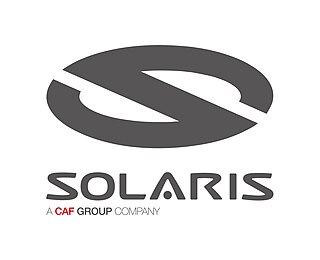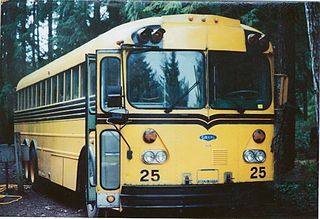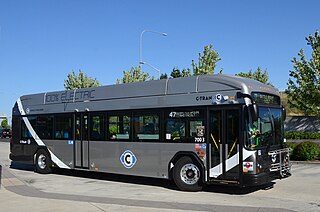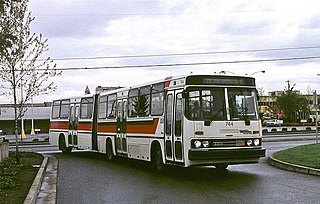
A trolleybus is an electric bus that draws power from dual overhead wires using spring-loaded trolley poles. Two wires, and two trolley poles, are required to complete the electrical circuit. This differs from a tram or streetcar, which normally uses the track as the return path, needing only one wire and one pole. They are also distinct from other kinds of electric buses, which usually rely on batteries. Power is most commonly supplied as 600-volt direct current, but there are exceptions.

Solaris Bus & Coach sp z o.o. is a Polish manufacturer of public transport vehicles, with its headquarters in Bolechowo-Osiedle near Poznań. It is a subsidiary of Spanish rolling stock manufacturer CAF with a market share for electric buses in Europe of about 18%.

Kenworth Truck Company is an American truck manufacturer. Founded in 1923 as the successor to Gersix Motor Company, Kenworth specializes in production of heavy-duty and medium-duty commercial vehicles. Headquartered in the Seattle suburb of Kirkland, Washington, Kenworth has been a wholly owned subsidiary of PACCAR since 1945, operating alongside sister company Peterbilt Motors.

The Neoplan Transliner was a series of related public transport single-decker bus models introduced by Neoplan USA in 1981 and produced until the company declared bankruptcy in 2006. It was available in various lengths ranging from 26 ft (8 m) to 60 ft (18 m) articulated, and was marketed against the Rapid Transit Series, Flxible Metro, Gillig Phantom, New Flyer High Floor, and Orion I.
The Greater Dayton Regional Transit Authority, formerly known as the Miami Valley RTA, is a public transit agency that generally serves the greater Dayton, Ohio area. The GDRTA serves communities within Montgomery County and parts of Greene County, Ohio, USA. There are 18 routes. RTA operates diesel and electric trolley buses seven days a week, 21 hours a day, and provides services to many citizens within the area. RTA's current CEO is Bob Ruzinsky. In 2023, the system had a ridership of 6,570,600, or about 19,800 per weekday as of the fourth quarter of 2023.

Van Hool NV is a Belgian family-owned coachbuilder and manufacturer of buses, coaches, trolleybuses, and trailers.
Neoplan USA was a major transit bus manufacturing company based in Denver, Colorado. It started as a subsidiary of the German corporation Neoplan in 1981 with its main factory and headquarters in Lamar, Colorado. In 1998, Neoplan USA was acquired by Willis Stein & Partners and became an independent licensee of designs from the German company Neoplan. The company declared bankruptcy in 2006.

The GM New Look bus is a municipal transit bus that was introduced in 1959 by the Truck and Coach Division of General Motors to replace the company's previous coach, retroactively known as the GM "old-look" transit bus.

The Gillig Phantom is a series of buses that was produced by an American manufacturer Gillig Corporation in Hayward, California. The successor to the long-running Gillig Transit Coach model line, the Phantom marked the transition of Gillig from a producer of yellow school buses to that of transit buses. The first transit bus assembled entirely by Gillig, the Phantom was produced exclusively as a high-floor bus.

The Gillig Transit Coach School Bus is a series of buses that were produced by the American bus manufacturer Gillig from 1940 to 1982. Alongside its namesake usage as a yellow school bus, the Transit Coach also served as the basis of motorcoaches and other commercial-use vehicles. Marketed primarily to operators on or near the West Coast of the United States, the Transit Coach competed nearly exclusively against the similar Crown Supercoach through much of its production.

The Gillig Low Floor is a transit bus manufactured by Gillig since 1997. The second low-floor bus design introduced in the United States, the Low Floor originally served as a second product range for the company alongside the Gillig Phantom. As transit bus operators shifted toward low-floor designs, the Low Floor has replaced the Phantom entirely, becoming the sole vehicle platform offered by the company since 2008.

The Seattle trolleybus system forms part of the public transportation network in the city of Seattle, Washington, operated by King County Metro. Originally opened on April 28, 1940, the network consists of 15 routes, with 174 trolleybuses operating on 68 miles (109 km) of two-way parallel overhead lines. As of the fourth quarter of 2023, the system carries riders on an average of 39,900 trips per weekday, comprising about 18 percent of King County Metro's total daily ridership. At present in Seattle, a very common alternative term for trolleybus is trolley.

The Dayton trolleybus system forms part of the public transportation network serving Dayton, in the state of Ohio, United States. Opened on April 23, 1933, it presently comprises five lines, and is operated by the Greater Dayton Regional Transit Authority, with a fleet of 45 trolleybuses. In 2023, the system had a ridership of 2,163,400, or about 6,400 per weekday as of the fourth quarter of 2023.

The Philadelphia trolleybus system forms part of the public transportation network serving Philadelphia, in the state of Pennsylvania, United States. It opened on October 14, 1923, and is now the second-longest-lived trolleybus system in the world. One of only four such systems currently operating in the U.S., it presently comprises three lines and is operated by the Southeastern Pennsylvania Transportation Authority (SEPTA), with a fleet of 38 trolleybuses, or trackless trolleys as SEPTA calls them. The three surviving routes serve North and Northeast Philadelphia and connect with SEPTA's Market–Frankford rapid transit line.

The Crown-Ikarus 286 is a type of transit bus that was manufactured for the U.S. market from 1980 until 1986, under a joint venture between the Ikarus Body and Coach Works (Ikarus), of Budapest, Hungary, and Crown Coach Corporation from Los Angeles, California in the United States. Loosely based on the Ikarus 280, the Crown-Ikarus 286 is a high-floor articulated bus.
As of 2017, King County Metro operates the 10th largest fleet of buses in the United States, with a total of 1,540 buses.
The Gillig Spirit is a bus that was manufactured by Gillig Corporation from 1989 to 1991. Marketed as a lower-cost alternative to the Gillig Phantom, the Spirit was produced as a transit bus. Through its production run, the Spirit was produced in a 28-foot length, with a 96-inch wide body; like the Phantom, the Spirit was a high-floor bus.

The Flyer 700/800/900 series were a series of transit buses built in three generations by Western Flyer and its successors Flyer Industries and New Flyer, of Canada, between 1967 and 1987. Except for brief overlap during transition from one generation to the next, they were not in production concurrently. All individual model designations included a prefix of either D, for diesel propulsion, or E, for electrically powered trolleybuses, with the first digit indicating the generation and the last digit indicating a variant within the generation. The introductory model was the D700, originally released in 1967 for the Canadian transit market, and the last series group to be produced, D900, was discontinued in 1987. Flyer had become New Flyer only the year before, in 1986.

The New Flyer High Floor was a line of conventional (high-floor) transit buses available in 35' rigid, 40' rigid, and 60' articulated lengths manufactured by New Flyer Industries between 1987 and 1996. The buses were powered by conventional diesel or natural gas engines using either V-drive or T-drive transmission couplings, with the exception of an articulated electric trolleybus variant manufactured for a single customer, the San Francisco Municipal Railway. The New Flyer Low Floor, a low-floor bus with a similar external appearance, was introduced in 1991 and proved to be more popular than the High Floor, which was discontinued in 1996 in diesel rigid form. CNG high-floor buses continued to be made until 1999, and the articulated version was manufactured until early 2006.




























